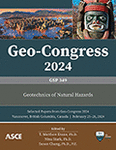Liquefiable Interlayer Effects in a Liquefaction-Susceptible Site
Publication: Geo-Congress 2024
ABSTRACT
The liquefaction response of a site is attributed to a variety of factors including the configuration of the site’s stratigraphy and interaction of its layers and interlayers. However, the effects of configuration and interaction of soil units have been overlooked by the simplified liquefaction assessment methods that are currently widely used by practitioners for assessing liquefaction effects in a site, resulting in the overestimation of liquefaction manifestations in many cases. One of the cases that could highlight the role of a site’s configuration is the presence of a liquefiable interlayer in a profile mainly consisting of liquefaction-susceptible deposits. This study uses an advanced nonlinear dynamic analysis (NDA) procedure in a finite difference platform to simulate the response of a synthetic liquefaction-susceptible site with a silty liquefiable interlayer to seismic loading to investigate how the interlayer presence affects the system response. The effects of the liquefiable interlayer are evaluated using liquefaction triggering and manifestation parameters in the profile of the site and motion responses on the ground surface. This study also accounts for the role of interlayer thickness by developing NDAs with varying interlayer thicknesses. The soil properties used for the synthetic profile in this study are from a calibrated and validated NDA for the Wildlife Liquefaction Array (WLA) site thereby, presenting realistic materials. The results of this study indicated that contrary to the prediction of simplified methods, the presence of a liquefiable interlayer in the middle of the profile could considerably alleviate the potential shaking and liquefaction deformation damages on the surface.
Get full access to this article
View all available purchase options and get full access to this chapter.
REFERENCES
Adampira, M., and Derakhshandi, M. (2019). “Influence of a layered liquefiable soil on seismic site response using physical modeling and numerical simulation”. Eng. Geol., 2020;266.
Boulanger, R. W., and Ziotopoulou, K. (2015). “PM4SAND (Version 3): A sand plasticity model for earthquake engineering applications”.
Boulanger, R. W., and Idriss, I. M. (2014). “CPT and SPT based liquefaction triggering procedures.”, Department of Civil and Environ. Eng., UC Davis, CA, U.S.
Cubrinovski, M., Rhodes, A., Ntritsos, N., and van Ballegooy, S. (2018). “System response of liquefiable deposits”. Soil Dynam. Earthq. Eng, 124:212–29.
Itasca Consulting Group, Inc. 2018. FLAC Ver. 8.1 User’s Guide. Minneapolis, MN.
Iwasaki, T., Tatsuoka, F., Tokida, K., and Yasuda, S. (1978). “A practical method for assessing soil liquefaction potential based on case studies at various sites in Japan”. Pp. 885–896 In Proceedings of the 2nd International Conference on Microzonation, San Francisco, California.
Karamitris, K., Bouckovala, G., and Yannis, C. (2013). “Insight into the Seismic Liquefaction Performance of Shallow Foundations”. J. Geotech. & Geoinvir. Eng., 139 (4).
Kargar, P., and Osouli, A. (2023). “Evaluation of Two Numerical Modeling Approaches for Liquefaction Investigation of Fines-Dominated Soils in Wildlife Liquefaction Array (WLA) Case Study”. Geo-Congress 2023. https://doi.org/10.1061/9780784484654.013.
Kargar, P., Osouli, A., and Kumar, S. (2023). “Liquefaction behavior evaluation of a multi-layered site with fines-dominated soils”. Soil Dynam. Earthq. Eng, 169: 107875.
Kokusho, T. (2014). “Seismic base-isolation mechanism in liquefied sand in terms of energy”. Soil Dynam. Earthq. Eng, 63:92–97.
Kuhlemeyer, R. L., and Lysmer, J. (1973). “Finite Element Method Accuracy for Wave Propagation Problems.” J. of the Soil Mech. and Found. Division, 99(5): 421–427.
Maurer, B. W., Green, R. A., and Taylor, O.-D. S. (2015). “Moving towards an improved index for assessing liquefaction hazard: Lessons from historical data”. Soils and Foundations 55(4):778–787.
Robertson, P. K., and Wride, C. E. (1998). “Evaluating cyclic liquefaction potential using the cone penetration test.” Can. Geotech. J., 35(3), 442–459.https://doi.org/10.1139/cgj-35-3-442.
Seed, H. B., and Idriss, I. M. (1971). “Simplified procedure for evaluating soil liquefaction potential.” J. Soil Mechanics and Foundations Div., ASCE 97(SM9), 1249–273.
van Ballegooy, S., Malan, P. J., Jacka, M. E., Lacrosse, V. I. M. F., Leeves, J. R., and Lyth, J. E. (2012). Methods for Characterizing Effects of Liquefaction in Terms of Damage Severity. In Proceedings of the 15th World Conference on Earthquake Engineering, Lisbon, Portugal.
Yoshida, N., Tokimatsu, K., Yasuda, S., and Kokusho, T. (2001). “Geotechnical Aspects of Damage in Adapazari City During 1999 Kocaeli, Turkey Earthquake”. Soils & Found., 41 (4):25–45.
Ziotopoulou, K., and Montgomery, J. (2017). Numerical modeling of earthquake-induced liquefaction effects on shallow foundations. 16th World Conference on Earthquake Engineering, Santiago, Chile, 9-13 January; Paper No. 2979.
Information & Authors
Information
Published In
History
Published online: Feb 22, 2024
ASCE Technical Topics:
- Analysis (by type)
- Continuum mechanics
- Dynamic analysis
- Dynamic loads
- Dynamics (solid mechanics)
- Engineering fundamentals
- Engineering mechanics
- Geomechanics
- Geotechnical engineering
- Geotechnical investigation
- Material mechanics
- Material properties
- Materials engineering
- Seismic loads
- Site investigation
- Soil analysis
- Soil dynamics
- Soil liquefaction
- Soil mechanics
- Soil properties
- Solid mechanics
- Structural dynamics
Authors
Metrics & Citations
Metrics
Citations
Download citation
If you have the appropriate software installed, you can download article citation data to the citation manager of your choice. Simply select your manager software from the list below and click Download.
